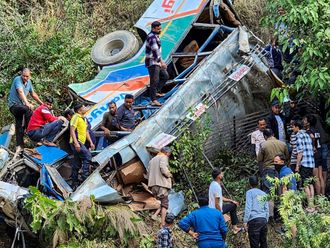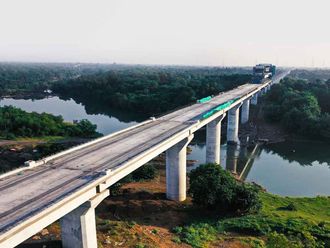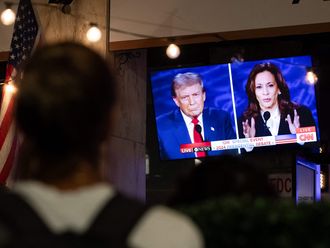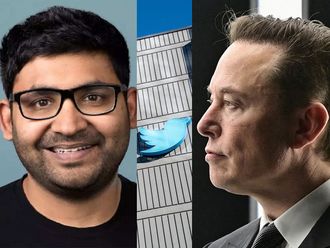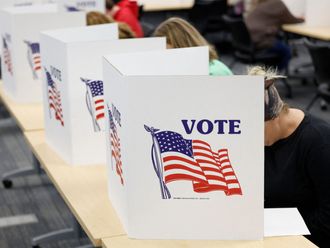Luxury living in India is coming with a price. Huge entrance gates, higher boundary walls and round-the-clock private security guards at private homes have become a necessity for the rich.
Incidentally, all this is not so much for the security of family treasures as it is for the safety of their children because ransom kidnappings are becoming more ruthless by the day.
Knowing that the police are in most cases ineffective, gangs of ransom-seekers prey on well-off families, kidnapping children and demanding money in return for their release. But many times these kidnappers also end up killing the children, even while desperate parents negotiate with them on the ransom.
India at present ranks as the fifth most dangerous country in the world for kidnapping. This, criminologists say, is the fallout of the country's economic boom, when a large section of society made a sudden leap into the ranks of the upper middle class. Those who were left behind make kidnappings their way of getting revenge, demanding their share of the spoils.
A report by the National Human Rights Commission (NHRC) says that at any given time, "more than 60,000 children go missing in India, out of which a dismal 30 per cent are traced. Many of them end up working as child labourers, drug mules or beggars."
The report also revealed the recent arrest in New Delhi of a gang of seven, headed by a woman, which sold children to childless couples. The gang had apparently kidnapped nine children and sold them to some "parents" for Rs50,000 to Rs70,000 (Dh3,726 to Dh5,216).
Figures show that about five children go missing in the capital every day, many falling prey to drug trafficking rackets.
Former director of the Central Bureau of Investigation (CBI) Joginder Singh told Weekend Review: "While children from poor families are generally trafficked or made to beg, those from affluent families are kidnapped for ransom. And in almost all cases, it is the domestic helps or the security guards who are the culprits. Not only do they know the movements of each family member, they are also aware of how wealthy a family is. This helps the masterminds behind the kidnapping. The desire to get rich quickly is the only motive behind such crimes. It is seldom done to exact revenge."
"I can't comprehend what stops the affluent parents from installing CCTV cameras at their palatial homes," he added. "If done, the children could be safe to a large extent. And in the case of a kidnapping, the cameras could help the police in investigations."
Even though Singh felt the kidnapped child's family should involve the police to gather circumstantial evidence, he admitted that "the police help only marginally".
Blaming the parents, he said: "Most of them are plain lazy. They neither keep photos of domestic helps in their records, nor get any kind of police verification done on the maids."
The police have launched initiatives, such as the "eyes and ears" programme, to look out for any suspicious activity. But there has been no end to kidnappings and no solution to find missing children.
Most parents feel that the police are partial to the rich and ward off other kidnapping complaints implying that the children must have wandered away or run away on their own. Disillusioned with such responses, parents lose hope and are left with no choice but be resigned to their fate. Some enterprising ones, however, try their own methods.
For instance, when 6-year-old Karnit from Mumbai was kidnapped, his father, Anand Shah, a stockbroker, launched a campaign on Facebook. "I posted my telephone number and Karnit's picture and sought help from the public," he said.
The post, which received hundreds of comments within a few days, turned into an online campaign. Promising a handsome reward to anyone providing any information, the distraught father waited for ten days, after which he received the first call from his son's abductors with a demand for a Rs10 million ransom. All along, Shah had also been in touch with the Mumbai police.
The mastermind was discovered to be a Sohanlal Gupta, the owner of a confectionary shop near Shah's residence in Kandivli. The delivery boys at Gupta's shop had kept watch on the children in the neighbourhood where Karnit lived. They befriended Karnit and his friends by giving them chocolates and cricket balls over a few days.
Seizing the opportunity on a day when Karnit was away from his friends, Gupta's employees lured him away with chocolates. Later Karnit was taken to Nasik on a motorcycle and from there to Allahabad by train.
A call made from a PCO and those from the abductors' mobile phones to accomplices in Mumbai helped the police track down the perpetrators. The child was rescued from Allahabad, Uttar Pradesh, in a joint operation by the Mumbai Crime Branch, Uttar Pradesh Anti-Terrorist Squad and the Allahabad Police.
In a similar case, Delhi-based Ishaan Singh's parents heaved a sigh of relief when their 18-month-old son was safely brought back to their Maharani Bagh home last April. The police rescued the child within a few days of his being kidnapped by the family's domestic help and her four accomplices for ransom.
Delhi Police Commissioner B.K. Gupta said: "The kidnappers had planned to keep the child with them for more than a month. In fact, they had made arrangements to feed him and look after him well. We found that the kidnappers had purchased baby oil, biscuits and other eatables when we rescued Ishaan from their clutches. It was a long-term plan to collect Rs20 million from the child's parents. But we formed 15 teams, which included one from the crime branch, and sent them to various parts of the country to look for the child."
"The police did a great job," Ishaan's mother said. "At no point did I feel I would lose my son. The teams would even drop by to inform us of the latest developments."
Son of a prominent businessman, Ishaan is one of the few lucky children to have been rescued. Sadly, most parents are left with just memories of their children.
Delhi Police figures show that kidnappings for ransom have been on an alarming rise. While in 2008 the capital witnessed 1,233 cases, the figure soared to 2,975 in 2010. This year till March 802 cases were registered, out of which only a few were recovered.
While criminal gangs are believed to be making several millions a year in ransom payments, another industry has been quick to cash in on this trend. Kidnap and ransom insurance policies are on the rise. Termed K&R policies, these offer financial protection to a client on his release from captivity. Both private and government-owned companies are now selling several hundreds of such policies every year.
"Earlier the policies were designed to protect individuals and corporations operating in high-risk zones around the world, but in present times, due to insecurity and the feeling of not being safe anywhere, people are getting themselves and their families insured," an ICICI Bank official told Weekend Review. "Even people from the middle class have begun enquiring about K&R policies. They know anyone can be a target, as kidnappings have become quite common. The upper middle class has as much to fear as the elite."
K&R insurance, which made inroads in Delhi and NCR in the late 1990s, was a nascent business till 2006, after which it abruptly picked up. This happened after two men on motorcycles kidnapped Anant, the 3-year-old son of Adobe CEO Naresh Gupta, from outside his home in Noida, bordering Delhi. The child was returned to his parents after five days upon the payment ofa Rs5 million ransom.
The incident set alarm bells ringing, and several corporate and insurance companies were approached by multinationals that hired expats to work in the country.
The National Crime Records Bureau reported 23,991 abductions in 2006 and 30,261 in 2008. The figure for 2009 pegged the number at 33,860, an 11.9 per cent increase over 2008. The states which reported the maximum number of kidnappings were Uttar Pradesh, Andhra Pradesh and Bihar.
Kidnapping for ransom has deep roots in the eastern state of Bihar. "It is the most popular career choice for the unemployed," a state police officer said of ransom kidnappings. "And due to the law and order situation, things have only worsened over the years."
"Bihar has more than 100 kidnap gangs and, unlike in other states, their targets here are not just the rich and famous but also people from the middle class. The situation is out of control, as some politicians have been hand-in-glove with the abductors — kidnappers have even been nabbed from the homes of politicians," he added.
In Delhi, the chauffeur-driven vehicles that drop and pick up most children from school are more a "better safe than sorry" approach by the parents than status symbols. As a security guard said: "The entire social system has fallen apart. People have become rich but in turn have lost their peace of mind. None of the Indian states are capable of tackling this crime that has seeped into our everyday lives."
The least risky way to extort money
"The family should prolong its negotiations with criminals and convey an impression that the ransom will be paid, to buy more time," Prakash Singh, who served as director-general of Border Security Force, the world's largest paramilitary force, and director-general of police, Uttar Pradesh and Assam, told Weekend Review.
Excerpts:
What could be the reasons for the rise in kidnappings?
Kidnappings could be for different reasons, including adoption, begging, marriage, prostitution, ransom, slavery, camel racing and revenge. Criminals resort to kidnapping for ransom because they find it the least risky way and a comparatively convenient method of extorting money from the parents or the family of the abducted person. The highest numbers of kidnappings are reported from Uttar Pradesh and Bihar. In fact, a recent phenomenon in Bihar has been that eligible grooms are kidnapped for marriage by parents of girls. This is done to avoid the custom of giving hefty dowries at the time of the daughter's marriage.
What should the police be doing?
The police need to proceed very cautiously in the case of a ransom kidnapping. They must be aware that any hasty action on their part could lead to physical harm to the victim, and must ensure they avoid any such situation. I know that during my tenure in Uttar Pradesh, several police officers acted as decoys pretending to pay the ransom amount on behalf of the family. At the 11th hour, they would alert the police personnel to raid the area and apprehend the culprits.
In one such case, a superintendent of police, in Farrukhabad, Uttar Pradesh, personally went to the criminals and managed to overpower them and rescue the abducted child.
With the technology available nowadays, the police should and do monitor all calls to locate the possible whereabouts of the criminals. But they must first gain the confidence of the aggrieved family. The police could also tap their own sources to identify the gang involved.
How should parents respond to and negotiate with the kidnappers?
The first step is to take the police into confidence. The family should prolong its negotiations with criminals and convey an impression that the ransom amount will be paid, to buy more time.
Tax rebate on ransom amount
In a landmark judgment, the Madhya Pradesh High Court has allowed businessman Sukhnandan Jain to claim a reduction in his tax liability for the amount he paid as ransom to his kidnappers.
A division bench of the court comprising Justices K.K. Lahoti and Vimla Jain said in an order passed in August that "nowhere is it provided that to save the life of a person, paying ransom amounts to an offence".
Upholding an income tax appellate tribunal's decision, the court allowed Jain to claim deduction on the ransom paid for his release from the kidnappers. The assessing officer had disallowed the claim on the ground that ransom was not an expenditure incidental to any business. The counsel for the revenue department told the income tax authorities that the law prohibited such payments. But on the appeal, the commissioner of the income tax allowed Jain's claim.
Director of a tobacco manufacturing company in Sagar, Madhya Pradesh, Jain was kidnapped by the notorious Raja Bhatnagar gang on August 5, 1987, while he was on a business trip. The businessman was released 22 days later after paying Rs550,000 to the kidnappers.
Subsequently, while filing his income tax return, he had showed the amount under general expenses and claimed an income tax deduction on it.
Nilima Pathak is a journalist based in New Delhi.



